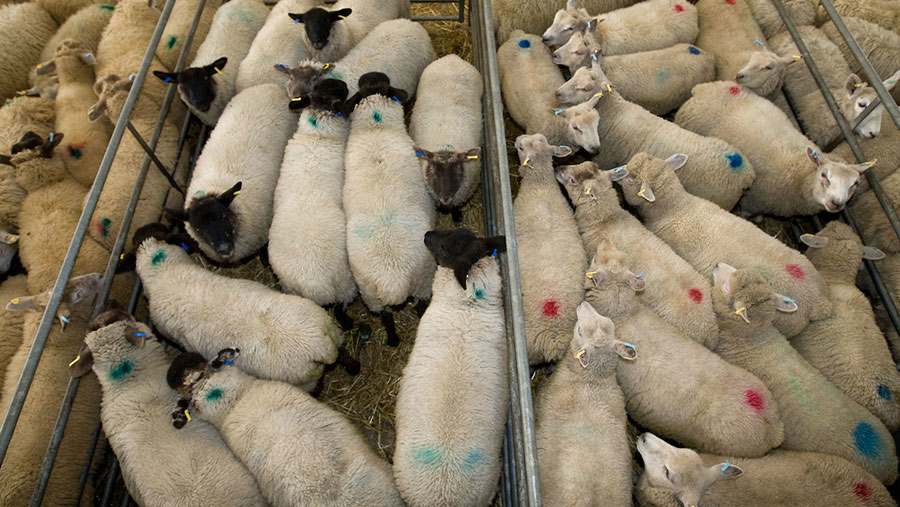Challenge for lamb sales in 2020 market
 © Tim Scrivener
© Tim Scrivener A sharp drop in demand for lamb due to the coronavirus pandemic has reversed earlier predictions of firm prices throughout 2020.
Prospects for lamb had been good at the start of the year, with tightening supplies expected to support prices.
However, the AHDB’s latest Lamb Outlook report suggests the market for the second half of 2020 will be dogged by Brexit uncertainty and the effects of Covid-19.
Outlook key points
- 7% fall in UK sheepmeat production expected in 2020
- Imports to decline again, driven by reduced product availability in New Zealand
- Consumer demand across Europe under pressure from Covid-19
UK prices
The lamb marketplace has shifted dramatically since late 2019, when forecasts suggested prices would be supported by tight supplies.
For the first two months of 2020 this predicted scenario played out. But export demand collapsed in mid-March as the Covid-19 crisis unfolded and farmgate prices came under intense pressure.
See also: Alternatives to selling livestock at markets this autumn
However, since late May, new-season SQQ lambs have been tracking well above 2019 values, averaging 478.1p/kg deadweight in the week to 27 July, almost 80p/kg above the year-earlier level.
The report warns that price prospects for the remainder of 2020 will centre on how the UK recovers from the Covid-19 crisis.
“A slow return to normality is likely to reduce domestic demand further, especially if unemployment levels rise significantly,” it warns.
Shoppers from lower-income households will look for cheaper alternatives to lamb and there may be a reluctance to eat out.
If the slow recovery is felt across Europe, export demand could also come under pressure, reducing total demand and adding to downward pressure on farmgate prices.
Alongside the effects of the pandemic, the end of the Brexit transition period is looming.
A no-deal outcome, or any deal that reduces the UK’s access for sheepmeat to Europe, will be likely to negatively affect export volumes and/or prices.
UK sheep production 2020
- Breeding flock 13.8 million head
- Lamb crop 16.8 million head (-1%)
- Lamb slaughter 12.6 million head (-4%)
- Ewe slaughter 1.5 million head (-9%)
UK sheepmeat production dropped by 11,000t between the end of March and July this year.
The AHDB suggests that production will be 2% down in the second half of 2020 compared with last year, putting the 12-month total at 287,000t.
The cull kill was exceptionally high during 2019, with carcass weights also higher. In 2020, kill numbers are forecast to decline slightly to more normal levels, with the decline blamed on economic uncertainty due to the pandemic and Brexit.
“The ongoing UK-EU negotiations offer little incentive for farmers to expand the size of their breeding flocks. This is likely to push production further down,” says the AHDB.
It also warns that future developments to farm subsidy payments could put further pressure on the size of the UK breeding flock.
Trade
Imports are forecast to decline this year, with overall volumes forecast to contract by 16%, to 62,600t. The fall is driven by a lack of product availability from New Zealand and high demand for meat proteins from China.
Prolonged rain following droughts in New Zealand and Australia have reduced flock sizes, negatively affecting their national production.
Exports are also forecast to reduce this year, in line with lower UK production.
However, demand in Europe is also under pressure from the coronavirus pandemic. The extent to which exports change is dependent on how quickly Europe recovers from the crisis.
Unemployment and reduced incomes, along with further restrictions on eating out will put even more downwards pressure on demand and prices, says the outlook.
Retail picture
Retail sales of lamb were down 3.7% year-on-year before Covid-19 struck.
This trend is likely to continue as shoppers buy less of almost every cut, with only mince in growth, driven by the need for versatility and convenience, the outlook suggests.
The Covid-19 lockdown hit lamb retail markets hard. In the 12 weeks to 17 May, volumes fell 7.5% compared with a 14.7% increase in total food sales over the 12 weeks to 17 May.
Eating out had fallen by 4% in the 12 months to December 2019 as lamb struggled to maintain share in popular dishes such as curries and roast dinners.
Losses for lamb in the retail market during lockdown are expected to continue, the report predicts, with the meat struggling to score points on versatility and price.
